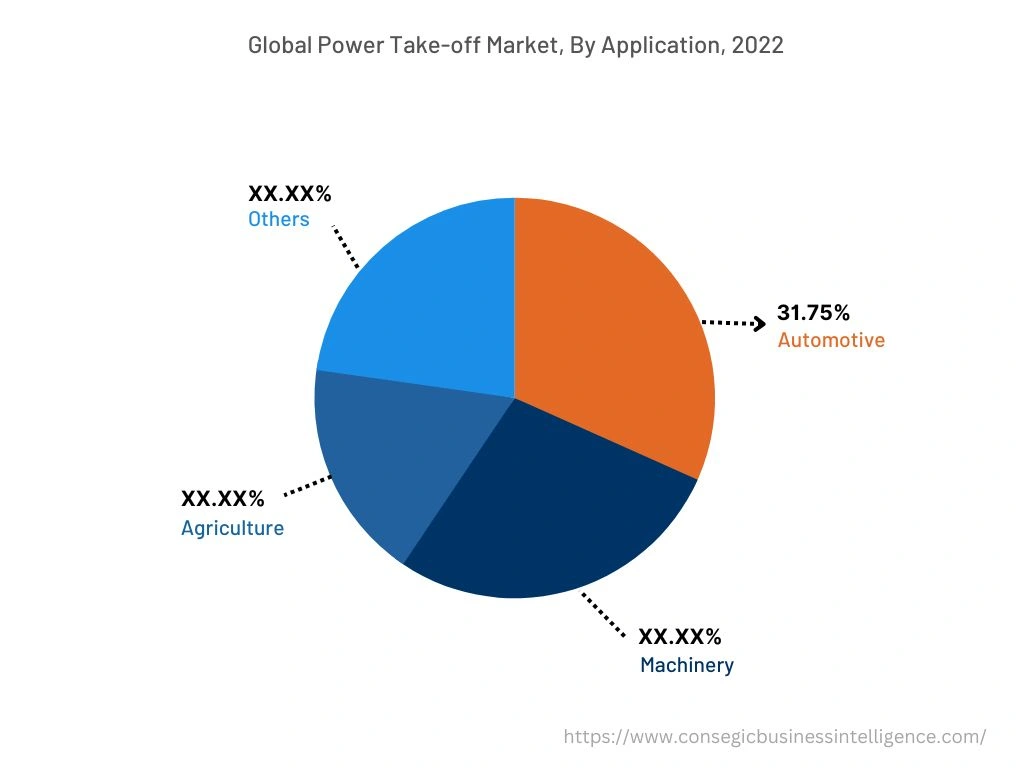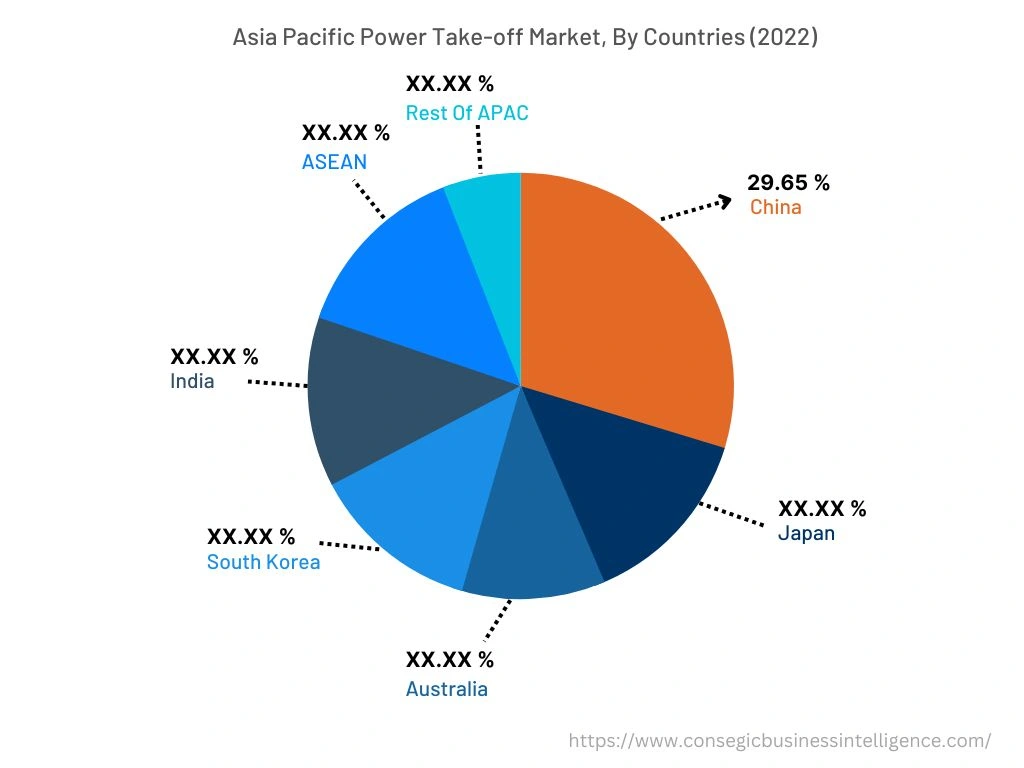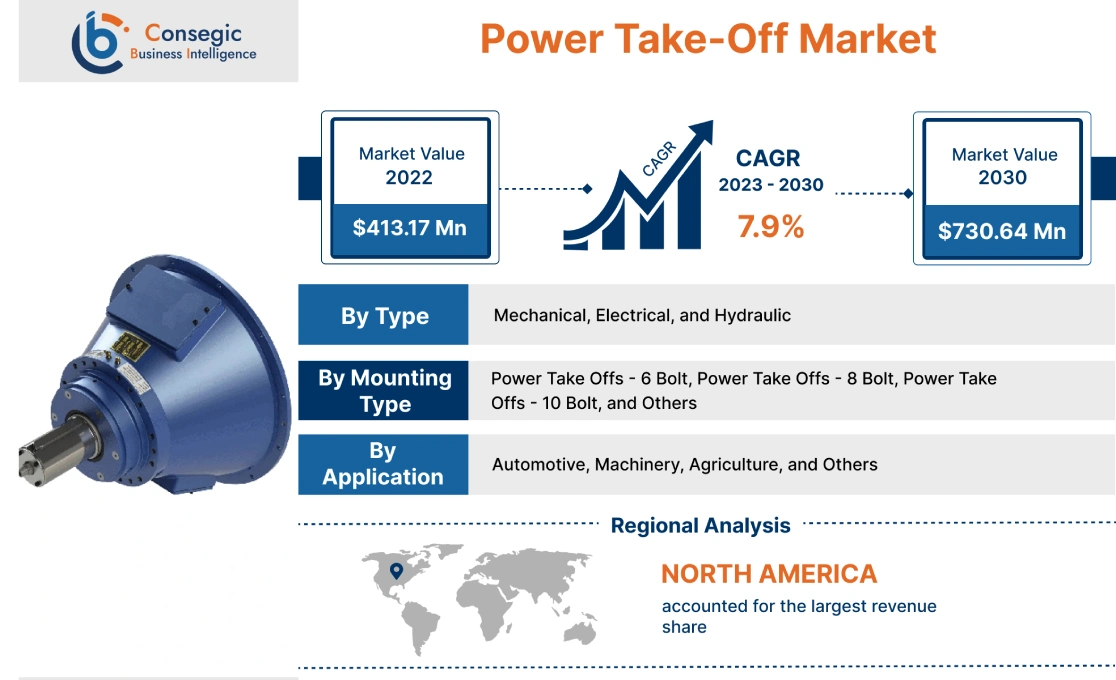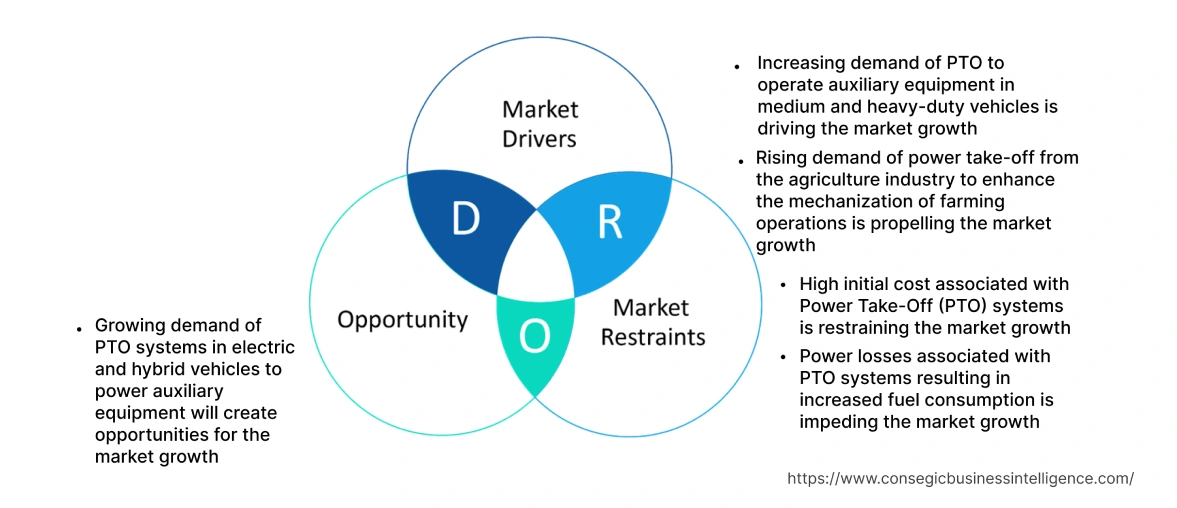Power Take-Off Market Introduction :
Power Take-Off Market size is estimated to reach over USD 730.64 Million by 2030 from a value of USD 413.17 Million in 2022, growing at a CAGR of 7.9% from 2023 to 2030.
Power Take-Off Market Definition & Overview :
Power Take-Off (PTO) system refers to a device employed in vehicles and machinery to transfer power from an engine or power source to operate auxiliary equipment. The system allows the vehicle's engine power to be harnessed to drive additional equipment that requires mechanical power. The equipment includes hydraulic pumps, generators, winches, compressors, and agricultural implements. In addition, the system is located at the rear of the vehicle or machine and is connected to the engine through a driveshaft to transfer power from the engine to the auxiliary equipment.
Power Take-Off Market Insights :
Power Take-Off Market Dynamics - (DRO) :
Key Drivers :
Increasing demand for PTO to operate auxiliary equipment in medium and heavy-duty vehicles is driving the market growth
Medium and heavy-duty vehicles including trucks and buses, require the operation of auxiliary equipment such as cranes, hydraulic pumps, winches, compressors, and power generators to perform specific tasks efficiently. These systems enable the transfer of power from the vehicle's engine or powertrain to operate auxiliary components effectively. In addition, according to the analysis, usage of these systems eliminates the requirement for separate power sources for auxiliary equipment, resulting in cost and time savings. Furthermore, the integration of these systems in heavy-duty vehicles streamlines operations and improves the efficiency of a vehicle. For instance, a truck-mounted crane lifts and transports loads, eliminating the requirement for a separate crane, thus reducing downtime and increasing productivity.
Consequently, the increasing demand for these systems in medium and heavy-duty vehicles to efficiently operate auxiliary equipment is driving the growth of the market. For instance, according to International Energy Agency (IEA), in 2022 approximately 60,000 medium- and heavy-duty trucks were sold globally, representing about 1.2% of truck sales and 4.5% of bus sales worldwide.
Rising demand of power take-off from the agriculture industry to enhance the mechanization of farming operations is propelling the market growth
The agricultural sector is increasingly adopting mechanization to improve productivity of the crop yield and this systems are essential for powering various machinery and equipment employed in farming operations. Auxiliary equipment including tractors, combines, balers and other agricultural machinery rely on these systems to operate mowers, harvesters, sprayers, and seeders. Additionally, the growing global population and changing dietary patterns are increasing the demand for crop production. Farmers strive to maximize crop yields and power-driven machinery enables farmers to perform various tasks including tilling, planting, irrigation, harvesting, and post-harvest handling more effectively and quickly. In conclusion, the capability of these systems to streamline farming operations, improve field safety, and enhanced crop yield contributes significantly to accelerating the growth of the market. For instance, in December 2022, Monarch Tractor launched the Monarch MK-V series equipped with a vision-based power take-off system. The system is installed to enhance the mechanization of farming operations, resulting in better crop yield and field safety, hence driving the market.
Key Restraints :
High initial cost associated with Power Take-Off systems is restraining the market growth
The major factor responsible for hampering the this market is the high cost of manufacturing the system, including the purchase of expensive components namely PTO shafts, yokes, and companion flanges. The high production cost mitigates small-scale businesses with limited financial resources to enter into the market. The upfront expenses involved in purchasing these equipment, including components, installation, and potential modifications to existing vehicles or machinery serve as a significant financial burden for small enterprises. Consequently, the aforementioned factors collectively contribute in restraining the power take-off market growth.
Power losses associated with PTO systems resulting in increased fuel consumption is impeding the market
Power losses in this systems occur due to friction, heat generation, and mechanical inefficiencies during transmission, resulting in reduced efficiency and performance. Inefficient power transfer leads to a decrease in the effective power available for the auxiliary equipment, affecting performance and productivity. In addition, power losses in these systems translate into wasted energy, resulting in increased fuel consumption and energy expenditure. The additional energy required to compensate for the power losses leads to higher operating costs for businesses, thus restraining the global power take-off market.
Future Opportunities :
Growing demand of PTO systems in electric and hybrid vehicles to power auxiliary equipment will create opportunities for the market
Electric and hybrid vehicles require an auxiliary power source to operate various systems and equipment including hydraulic systems, compressors, and refrigeration units. These systems are essential to provide the necessary power for the efficient functioning of auxiliary equipment. In addition, electric and hybrid vehicles are increasingly adopted in commercial applications namely delivery vans, utility trucks, or public transportation. The vehicles require additional power to operate specialized equipment including lifts, cranes, and refrigeration units. These systems offer a convenient and efficient solution for powering such auxiliary functions, enabling enhanced functionality and versatility for fleet operators. Subsequently, as per the analysis the surge in the number of electric and hybrid vehicles is expected to create potential opportunities for the development of the power take-off market. For instance, according to International Energy Agency (IEA), 26 million electric cars were sold worldwide in 2022, showcasing a relative rise of 60% in comparison to the previous year 2021. The rise in the sales of electric cars thus contributes significantly to creating lucrative power take-off market opportunities in the upcoming years.
Power Take-Off Market Report Insights :
| Report Attributes | Report Details |
| Study Timeline | 2017-2030 |
| Market Size in 2030 | USD 730.64 Million |
| CAGR (2023-2030) | 7.9% |
| Based on the Type | Mechanical, Electrical, and Hydraulic |
| Based on the Mounting Type | Power Take Offs - 6 Bolt, Power Take Offs - 8 Bolt, Power Take Offs - 10 Bolt, and Others |
| Based on the Application | Automotive, Machinery, Agriculture, and Others |
| Based on the Region | North America, Europe, Asia-Pacific, Latin America, and Middle East & Africa |
| Key Players | Bezares, CNH Industrial N.V., Hyva, Interpump Group S.p.A., Kozanoglu Kozmaksan Ltd., O.M.F.B. S.p.A., Ozceylanlar Hydraulic Co., Parker Hannifin Corporation, Sunfab Hydraulics AB, Viatec Inc., Weichai Power Co., Ltd, ZF Friedrichshafen AG |
Power Take-Off Market Segmental Analysis :
Based on the Type :
The type segment is trifurcated into mechanical, electrical, and hydraulic. Mechanical power take-off accounted for the largest market share in 2022 as mechanical PTO is a cost-effective system in comparison to hydraulic and electrical systems. Additionally, mechanical power take-off systems are extensively deployed in agricultural, construction, and industrial applications as the systems offer compatibility with a wide range of equipment and machinery. Mechanical power take-off systems are flexible and accommodate different power requirements and equipment configurations, becoming suitable for various applications. Subsequently, the aforementioned factors are collectively responsible in driving the trend of the power take-off market.
Electrical power take-off is expected to register the fastest CAGR during the forecast period. The requirement is attributed to the high power density offered by electrical power take-off to transmit large amounts of power in compact and lightweight designs. In addition, electrical power take-off systems offer smooth and precise power transmission, allowing for fine control over the auxiliary equipment. Moreover, as per the analysis electrical systems minimize power losses and wastage during power transmission, resulting in improved system efficiency, thus driving the trend of the market. Furthermore, the advancements in technology including longer battery life to offer emission-free power to auxiliary equipment is also propelling the market. For instance, in October 2022, Hiab launched HIAB ePTO 44, a second-generation electrical power take-off, with longer battery life and lower weight. The product is designed to reduce energy costs by up to 90%, allowing greater energy efficiency, thus contributing considerably in propelling the market.
Based on the Mounting Type :
The product segment is classified into power take-offs - 6 bolt, power take-offs - 8 bolt, power take-offs - 10 bolt, and others. 6-bolt power take-off accounted for the largest market share in 2022 as 6-bolt power take-off is highly compatible with a broad range of equipment and machinery. Additionally, the 6-bolt power take-off is easily integrated into different powertrain configurations, allowing for seamless installation and connection to auxiliary equipment. Moreover, the advancements in technology to reduce carbon footprints and fuel consumption are also contributing significantly in promoting the trend of the market. For instance, in November 2022, AB Volvo Penta introduced D16 MH/MG IMO Tier III with 6-bolts and selective catalytic reduction (SCR) technology. The product is designed to lower emission and fuel consumption, thus contributing remarkably in accelerating market trend.
8-bolt power take-off is anticipated to witness the fastest CAGR during the forecast period. The development of the market is attributed to the increasing application of 8-bolt system in heavy-duty vehicles owing to the high strength and suitability. In addition, the 8-bolt system also offers improved reliability and performance to transmit power efficiently in various end-use industries including automotive, construction, and mining. Furthermore, industries are transitioning towards more advanced and specialized equipment that requires higher power output and increased torque capacity. These systems with an 8-bolt mounting type provide the necessary power transmission capabilities for such equipment, thus contributing notably in accelerating the market.
Based on the Application :
The application segment is categorized into automotive, machinery, agriculture, and others. Automotive accounted for the largest market share of 31.75% in 2022 as these systems are employed in dump trucks and tippers to power the hydraulic systems responsible for raising and lowering the tipper mechanism. The system transfers power from the vehicle's engine to the hydraulic pump, allowing for efficient and controlled operation of the dumping or tipping function. Additionally, these systems are essential in fire trucks and emergency vehicles to power various auxiliary equipment including hydraulic pumps, generators, and air compressors further driving the trend of the market. Furthermore, the increasing adoption of this system in medium and heavy-duty vehicles to transit power efficiently to auxiliary equipment is also contributing considerably in propelling the market. For instance, in August 2020, Eaton launched a new "wet kit" to support Bezares' line of power takeoff units. The advanced wet kits are installed in medium- and heavy-duty trucks to transmit power to cranes and booms, thus contributing notably in accelerating the market.
Agriculture is predicted to register the fastest CAGR in the power take-off market during the forecast period. This systems in agriculture are primarily deployed to power a wide range of equipment attached to tractors including rotary tillers, mowers, balers, sprayers, seeders, spreaders, and hay rakes. The system transfers power from the tractor's engine to the equipment, allowing for efficient and effective operations in field preparation, crop management, and harvesting. In addition, the systems are utilized to power irrigation pumps in agricultural settings by enabling the extraction and distribution of water for irrigation purposes. Power-driven irrigation systems ensure a reliable water supply for crops, increasing productivity and water management efficiency. Subsequently, based on the power take-off market analysis the aforementioned factors including the increasing adoption of this system in tractor-driven equipment and irrigation system serve as the major factors in driving the demand of the agriculture segment.

Based on the Region :
The regional segment includes North America, Europe, Asia Pacific, Middle East and Africa, and Latin America.

North America accounted for the largest global power take-off market share in the year 2022 owing to the early adoption of advanced technologies including these systems to effectively transfer power from the engine to auxiliary equipment. Additionally, the region encompasses key manufacturers that invest heavily in research and development to improve product performance, efficiency, and compatibility. Moreover, the key players also apply strategic decisions through mergers and acquisitions to expand the existing customer base and to strengthen the market position. Consequently, according to the analysis, the early adoption of advanced technologies and the presence of key players serve as the major factor responsible for accelerating the demand of the power take-off industry in North America. For instance, in March 2023, Perkins launched an advanced power solution with cutting edge-technology to deliver high-density power to equipment. Based on the analysis new solution complies with the standard emission regulations, thus contributing significantly in driving the power take-off market trend in the North American region.
Asia Pacific accounted for USD 97.71 million in 2022 and is expected to register the fastest CAGR of 8.2% accounting to USD 176.45 million in 2030 in the power take-off market. In addition, in the region, China accounted for the maximum revenue share of 29.65% in the year 2022. The development in the region is attributed to the expanding agricultural sector in countries including China and India raises the advanced power take-off market demand for systems. As per the analysis, these systems are essential to power irrigation pumps in agricultural settings by enabling the extraction and distribution of water for irrigation purposes. In conclusion, the expanding agriculture industry is the major factor responsible for driving the trend of the market in Asia-Pacific countries.

Top Key Players & Market Share Insights :
The landscape of the power take-off market is highly competitive and has been examined in the report, along with complete profiles of the key players operating in the industry. In addition, the surge in innovations, acquisitions, mergers, and partnerships has further accelerated the growth of the power take-off market. Major players in the market include-
- Bezares
- CNH Industrial N.V.
- Sunfab Hydraulics AB
- Viatec Inc.
- Weichai Power Co., Ltd
- ZF Friedrichshafen AG
- Hyva
- Inland PackagingInterpump Group S.p.A.
- Kozanoglu Kozmaksan Ltd.
- O.M.F.B. S.p.A.
- Ozceylanlar Hydraulic Co.
- Parker Hannifin Corporation
Recent Industry Developments :
- In September 2022, Hiab, a part of Cargotec Corporation launched HIAB iX.162 HiPro loader crane with an integrated electric power take-off system. The electric PTO system is present on the base of the crane to fasten the installation process.
- In November 2021, Viatec introduced an advanced electric power take-off solution to offer a cleaner source of power to electric motors and batteries.
Key Questions Answered in the Report
What is Power Take-Off? +
Power Take-Off (PTO) refers to a device employed in vehicles and machinery to transfer power from an engine or power source to operate auxiliary equipment. The power take-off allows the vehicle's engine power to be harnessed to drive additional equipment that requires mechanical power.
What specific segmentation details are covered in the power take-off market report, and how is the dominating segment impacting the market growth? +
Automotive segment accounted for the largest market share in 2022 by application as power take-off systems are employed in dump trucks and tippers to power the hydraulic systems responsible for raising and lowering the tipper mechanism.
What specific segmentation details are covered in the power take-off market report, and how is the fastest segment anticipated to impact the market growth? +
The agriculture segment accounted for the largest market share as power take-off systems are primarily deployed to power a wide range of equipment attached to tractors including rotary tillers, mowers, balers, sprayers, seeders, spreaders, and hay rakes.
Which region is anticipated to witness the highest CAGR during the forecast period, 2023-2030? +
Asia Pacific is anticipated to witness the fastest CAGR during the forecast period due to the expanding agriculture sector.


